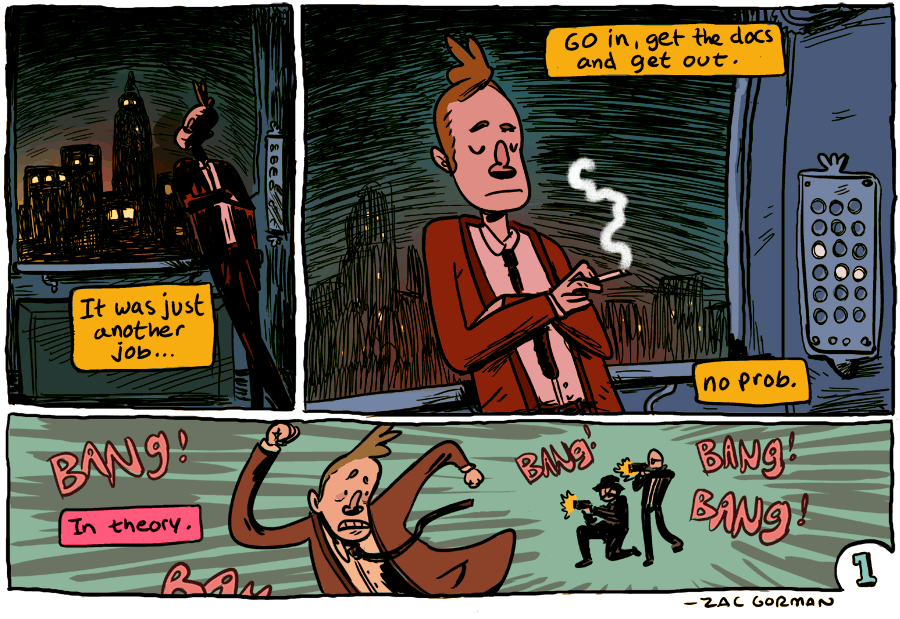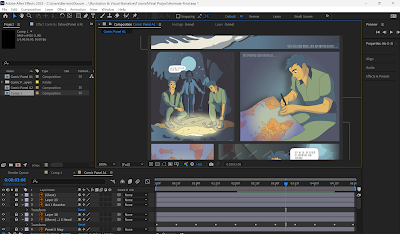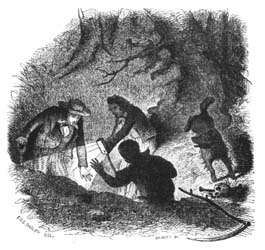Illustration and Visual Narrative - Project 3: Digital Triptych & Final Project
Ting Wen Yi / 0361799
Illustration and Visual Narrative/Bachelor of Design (Hons) in Creative Media
Project 3: Digital Triptych & Final Project
CONTENT
1. Lectures
2. Practical
3. Instructions
4. Research & Inspiration
5. Project 3 - Digital Triptych
6. Final Project - Animated Comic
7. Compilation
8. Feedbacks
9. Reflections
LECTURES
PRACTICAL
Week 10: Chiaroscuro
 | |
|
 |
| Figure 1.3 Tracing Out the Pear Shape |
 |
| Figure 1.4 Pear & Skull |
This week, we are supposed to use the pen tool to trace the pear shape. Then, we will take the skull and perform image tracing. After selecting the skull, I will place it on top of the pear, change the color, and use the shape builder to remove any extra parts.
 |
| Figure 1.5 Textures |
For the next task, Mr. Hafiz talked about placing textures and changing the colors.
INSTRUCTION
Project 3: Digital Triptych
1.Pick one story from : https://poestories.com/stories.php
2. Read the story and break down the storytelling basics:
- Central characters
- Setup, Conflict, Resolution
3. Employ the three-acts structure fill in-the-blank exercise to write your summary. Limit the word count to maximum 300 words only.
4. Roughly sketch out your triptych design based on the written summary.
Final Project: Animated Comic
Continuing from Project 3, based on the selected story, create a ONE PAGE introduction of your visual novel or comic to your readers…
1. Continue with the same story and design aesthetics from Project 3
2. Work only from one paragraph of the story for the 1st page.
The Gold Bug - Summary (A search for pirate treasure)
In Edgar Allan Poe's "The Gold Bug," the story unfolds with the unnamed narrator visiting his friend, William Legrand, on Sullivan's Island. Their peaceful time together takes a thrilling turn when Legrand discovers a peculiar gold bug that captivates his attention. This discovery becomes the catalyst for an adventurous quest.
Legrand becomes obsessed with a cryptogram attached to the beetle's leg, drawing the narrator and Legrand's servant, Jupiter, into his pursuit. Days pass as Legrand dedicates himself to deciphering the cryptogram, but his mental state deteriorates under the weight of his obsession.
Undeterred, the trio embarks on a dangerous journey, following the cryptogram's clues. They face physical obstacles and witness Legrand's increasingly erratic behavior. Despite the challenges, their determination pushes them forward.
Their quest leads them to a nearby island, where they encounter a swarm of insects that they must fend off to progress. In the face of adversity, they eventually unearth the buried treasure, achieving their ultimate goal.
The resolution brings relief as the characters successfully retrieve the treasure, freeing Legrand from his obsession. The story concludes with the characters reveling in their newfound wealth, highlighting the bonds forged through their shared adventure.
Poe's "The Gold Bug" takes readers on a gripping journey, unfolding in three acts. Act 1 introduces the characters and the discovery of the gold bug. Act 2 delves into the conflict of Legrand's obsession and the pursuit of the cryptogram. Act 3 resolves the story as the characters overcome obstacles and find the hidden treasure. With its mystery and triumph, "The Gold Bug" remains a timeless tale of adventure and human resilience.
Central Characters:
- Unnamed Narrator: The main character and the story's narrator. He serves as a close friend of William Legrand and becomes involved in the search for treasure.
- William Legrand: An eccentric character who discovers a mysterious bug, which leads him to find a cryptogram containing clues to a hidden treasure. He is the primary driver of the plot and takes the narrator on a thrilling journey.
- Jupiter: Legrand's loyal and superstitious servant. Despite his initial reluctance, he becomes an essential part of the treasure hunt and aids Legrand and the narrator.
Act 1: Setup
Once upon a time, there was an unnamed narrator who embarked on a quest for knowledge and adventure. Everyday, he sought intellectual stimulation and engaged in captivating conversations with his friend, William Legrand. One day, during a visit to Legrand's home on Sullivan's Island, the narrator made a surprising discovery. Hidden within Legrand's study, they found an old journal concealed among the books and artifacts. Intrigued by this unexpected find, their curiosity was piqued, and they eagerly delved into the cryptic sketches and coded messages within the journal. Little did they know, this journal held the key to a profound mystery that would consume their lives.
Act 2: Confrontation
One day, as they deciphered the cryptic messages within the journal, a new world of secrets and hidden knowledge began to unfold. Because of that, their understanding of Legrand's obsession with the gold bug and the cryptogram deepened. They realized that it was not solely driven by the pursuit of wealth, but by a desperate need to uncover a long-lost family legacy. Guided by the clues within the journal, the characters embarked on a journey that would lead them to a hidden family fortune and expose a dark secret that could jeopardize Legrand's reputation and very existence.
Act 3: Resolution
Until finally, the characters confront the truth behind the family secret. With each step of their relentless pursuit, they inch closer to unraveling the mystery. The gold bug, the cryptogram, and the hidden journal culminate in a climactic revelation. They discover that the treasure they sought was not mere material wealth, but a profound knowledge of immense power, guarded by Legrand's ancestors for generations. Now faced with a pivotal decision, they must choose whether to protect this secret, keeping it hidden from the world, or to release it, fully aware of the potential consequences it may unleash. The story reaches its climax as the characters grapple with the weight of their choices and the profound implications of their discoveries.
2. Research & Inspiration
I am using this artwork as inspiration because the flat illustration is very clean, and the artist incorporates stippling to add texture. Additionally, the triptych format utilizes three primary colors: red, blue, and yellow.
The artwork titled "Blood, Sweat, Tears" is a conceptual piece created by Jared Maire featured on Behance. "Cryptic Triptych 2" feature complex imagery, symbols, or abstract elements that invite the viewer to engage in a deeper exploration and interpretation.
This is an illustration from the book " The Gold Bug" where they uncover a hidden family treasure. I can use this as inspiration in my first act.
 | |
|
I have found a picture of the gold bug to use as a reference for how the bug might look. Referencing the picture can help me visualize the colors and details I may want to incorporate into my own bug illustration.
 |
| Figure 2.5 Comic Layout Before I draw up the comic I look up for arrangement of panels and content across an entire comic page. |
 |
| Figure 2.6 Reference 1 |
 |
| Figure 2.7 Reference 2 |
After conducting some research on art styles, I have discovered a particular style that resonates with me. I am drawn to art styles that incorporate elements of luminance, shadows, and gradients.
 |
| Figure 2.8 Reference 3 |
The background of the artwork is minimalistic, with a smooth gradient that allows the focus point (house) to stand out. The effective use of negative space enhances the focus on the mountains and the house, making them the central visual elements.
After Mr. Hafiz feedback I also researched about the use of foreground, middle-ground, and background elements within panels to create depth and add visual complexity to the artwork.
| Figure 2.10 Reference 4 |
 |
| Figure 2.11 Reference 5 |
 |
| Figure 2.12 Reference 6 |
I conducted some research on GIF comic animation, which helped me become familiar with different possible ways of animating my comic.
PROJECT 3: DIGITAL TRIPTYCH
1. Sketches
 |
| Figure 3.1 Sketch of Triptych " The Gold Bug" in Procreate - Week 9 (7/6/2023) |
Based on the reading of the book, I have analyzed it into three parts: Act 1, Act 2, and Act 3. In the first panel (Act 1), Legrand, the narrator, and Jupiter discover a mysterious artifact, known as the gold bug, which possesses a hidden message. To represent this, I drew a scene where the three of them found an old journal buried underground, containing clues related to the gold bug and its secret.
Moving on to panel 2 (Act 2), Legrand's obsession with the gold bug and the cryptogram is not solely motivated by the pursuit of wealth. Hence, I depicted Legrand holding the gold bug, surrounded by a backdrop filled with papers, symbolizing his deep involvement and obsession with unraveling the bug's secrets.
In the final panel (Act 3), the three of them successfully decipher the cryptogram and locate the hidden treasure. They embark on a thrilling adventure, following the clues from the journal and overcoming various challenges. Although the story doesn't explicitly state that Jupiter received a portion of the treasure, it is believed that he also received a share of the newfound wealth. Therefore, I portrayed a scene where they divide the treasure among themselves, ensuring that Jupiter is included in the distribution.
2. Digitize
 |
| Figure 4.1 Outline of Triptych " The Gold Bug" in Illustrator - Week 11 (16/6/2023) |
I placed my sketch in Illustrator and traced the image using the pen tool and pencil tool. I made slight changes to the last panel to they find the treasure in a cave on an island.
 |
| Figure 4.2 Filled Colors " The Gold Bug" in Illustrator - Week 11 (17/6/2023) |
Then, after completing all the tracing, I began filling in the colours using the paint bucket tool. I just filled it with flat colours.
 |
| Figure 4.3 Added Shadow Triptych " The Gold Bug" in Illustrator - Week 11 (19/6/2023) |
Afterward, I added shadows to the drawings to make them more lively. It took me a couple of days to trace and color the triptych. I am still in the process of familiarizing myself with the software.
 |
| Figure 4.4 Pre-Final Triptych " The Gold Bug" in Illustrator - Week 12 (25/6/2023) |
Final Triptych
 |
| Figure 5.1 Final Triptych " The Gold Bug" JPEG - Week 12 (25/6/2023) |
I added non-spoiler text for each act.
Figure 5.2 Final Triptych " The Gold Bug" PDF- Week 12 (25/6/2023)
FINAL PROJECT : MOTION COMIC
1. Planning & Sketches
Figure 6.1 Planning - Week 12 (24/6/2023)
Before I start to do my sketches I planned out each panel and the conversation they are going to have.
 |
| Figure 6.3 Page 2 Sketch in Procreate - Week 12 (24/6/2023) |
 |
| Figure 6.4 Page 3 Sketch in Procreate - Week 12 (24/6/2023) |
I drew 20 panels for the comic, spread across three and a half pages. I summarized the stories by choosing important moments and creating short visual narratives. Each panel showed a specific scene or event, letting the story unfold gradually as readers went through the pages.
2. Digitize in Illustrator
 |
| Figure 7.1 Digitize Process - Week 12 (26/6/2023) |
After completing all the sketches, I digitize them in Illustrator using the pen tool and pencil tool. I draw up all the panels to match the sketches accurately.
 |
| Figure 7.2 Filling Colors - Week 13 (5/7/2023) |
 |
| Figure 7.3 Adding Speech Bubbles & Phrases - Week 13 (5/7/2023) |
After filling in all the colors and shadows, I made the borders black to match the dark theme. I added the necessary speech bubbles and text phrases to enhance the storytelling aspect.
 |
| Figure 7.6 Cover Page - Week 13 (6/7/2023) |
I use one of the triptych panels as the cover page for the project. To achieve a less cartoony appearance, I modified the character's look. I also designed the cover page to resemble a book, incorporating relevant elements and details.
Figure 7.7 One Page Visual Novel Act 1 with Cover PDF - Week 13 (6/7/2023)
 |
| Figure 8.1 Animating GIF - Week 13 (6/7/2023) |
4. Final Compilation
Figure 9.1 Final Project Compilation - Week 13 (6/7/2023)
Google Slides Final Project Compilation: Click Here!
PROJECT 3 & FINAL PROJECT COMPILATION
Figure 10.1 Project 3 & Final Project Compilation - Week 13 (6/7/2023)
FEEDBACKS
Week 10: The sketches are quite decent. Make sure that the colors of the triptych harmonize with each other.
Week 11: For the second panel of the triptych, should include a middle-ground, increase the size of the paper, and adjust the background to make it less blended.
REFLECTIONS
Experience
Creating a digital triptych was an incredibly fascinating and creatively stimulating experience for me. In the initial phase, I brainstormed ideas and sketched rough drafts, envisioning how each panel would contribute to the overall narrative. During the coloring process, I experimented with layering, blending modes, and various visual effects. The ability to easily undo and revise allowed me to refine my work, exploring different compositions and experimenting with color palettes until I achieved the desired mood and atmosphere for each panel. During the animation process, as a newbie to the software, I encountered several challenges such as blurry images and a short timeline. However, I dedicated myself to researching and watching tutorials to overcome these obstacles. Through this exercise, I gained valuable knowledge and successfully resolved the issues I faced.
Observation
I discovered that balancing midground, background, and foreground is essential for achieving a harmonious composition. Paying attention to the arrangement of elements in the midground, background, and foreground helped me create a more visually pleasing and well-balanced drawing.
Findings
Throughout my project, I found the significance of incorporating elements in the midground, background, and foreground in drawings. Previously, I had predominantly focused on the main subject of my drawings, neglecting to consider the depth and dimensionality that these additional layers can bring. The inclusion of a midground, background, and foreground significantly enhances the depth and visual appeal of a drawing. Incorporating these layers adds a sense of depth and dimension to the artwork, making it more visually engaging. I found that if you aim to create a seamless and recurring video or GIF, it is essential for the last frame to match seamlessly with the first frame. This ensures that when the animation loops, there is no noticeable break or interruption in the sequence.














Comments
Post a Comment